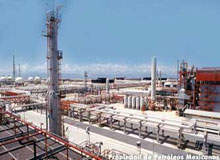
Petroblas Mexicanos (Pemex)’s oil refinery expansion in Cadereyta, Mexico, had its official start in April 2002. Also known as the Hector R Lara Sosa Refinery, the plant has undergone tests to guarantee safety and efficiency since 2001. The 275,000bpd facility is located on the outskirts of Monterrey, Mexico’s northern industrial capital.
The Cadereyta Refinery Reconfiguration Project (CRRP) improved the structure of the Mexican petroleum industry, which was set for an upturn in petrol and diesel sales in northern Mexico. Mexico imports approximately 40% of fuel for domestic consumption and demand is expected to increase by 5% by 2012.
The CRRP was an unprecedented huge-scale construction, with the construction of ten new plants, expansion of four plants and building a 1,317km crude oil pipeline. Fourteen other plants, including a refinery plant producing 155,000bpd of fuel and a 65,000bpd fluidised catalytic cracking plant, were modernised and expanded.
The project boosted the northern refinery’s output of unleaded and cleaner diesel, reduced sulphur emissions and allowed it to process heavy crudes more efficiently.
In September 2010, an explosion at the refinery killed one worker and injured ten. The explosion was caused by a leak in a compressor of a desulphurisation unit.
Delays at the Cadereyta refinery
The CRRP was delayed twice. The first time was for one year in 1997, when Pemex extended the bid submission date up to October 1997, even though the tender documents were issued in the middle of 1996.
The second time was for one year in 2000 due to a force majeure, Pemex acts and omissions, and additional works requested by Pemex. Pemex granted an extension to the completion date from 2 July 2000 to 21 April 2001. The work was carried out under a public works financing project that had not been used in Mexico. As soon as the plant was completed, consortium Conproca handed the refinery back to Pemex.
Lead contractors
The winning consortium, Conproca, led by SK Engineering and Construction, was awarded the contract in November 1997. SKEC was in charge of financing, engineering, procurement, construction and commissioning of the entire project.
Other leading contractors included Siemens, which covered the engineering and construction of all electrical instrumentation. Siemens’ role in this project was to modernise and install the control systems for the refinery, enabling the plant to double production of petrol, diesel and kerosene. The firm also implemented the automation systems for point-of-sale terminals and the Scada system for pump station monitoring and remote control. It also divided the Cadereyta crude oil pipeline into various sections.
Siemens awarded a contract to ILF Consulting Engineers for a 1,200km, 24in-diameter crude oil pipeline. The company provided extensive consultation in process hydraulics, operation commissioning and line-fill of the pipeline system. It also gave a definition of the automation concept, issue of detailed logistics, contract management for application-specific software and consulting regarding contractual matters.
The pipeline transports oil to the refinery from the oil production areas in south-east Mexico, and improves the capacity of other pipelines in the area.
Rotork Houston successfully bidded to supply 800 IQ actuators and Pakscan systems for the refinery. It won the contract despite fierce competition from Europe and the US.
Tribasa began building the long-distance crude line, but went bankrupt in October 1998. SKEC took over all of Tribasa’s responsibilities for the project and carried out the construction works for the pipeline, which was completed in 2002.
Infrastructure
The Cadereyta refinery is the third-largest and most sophisticated plant of its kind in Mexico. The plant infrastructure includes atmospheric distillation, an alkylation plant supplied by UOP, a methyl tertiary-butyl ether plant, a sulphur recovery plant, a hydrogen plant, a sour water stripping and exhaust unit, an RFCC plant, two crude distillation plants, a light fractionation plant, a naphtha HDS plant, two intermediate distillated product HDS plants, an asphalt mixing unit, a sulphur recuperator plant and a naphtha reformer plant.
New refinery upgrade
In February 2007, Pemex announced it would carry out a $600m upgrade of the Cadereyta refinery as part of a $3bn commitment to produce petrol and diesel with ultra-low sulphur content. The project includes the addition of catalytic petrol desulphurisation plants, amine regeneration units, utilities and offsites.
The upgrade also covers the construction of six new plants and the modernisation of a seventh. In addition, a $30m water-treatment plant will be built.
In August 2009, international tenders were invited and a $638m EPC contract was awarded to ICA Fluor, a joint venture of Fluor Corp and Empresas ICA. The project will be completed in 2012.
The $3bn programme aims to reduce sulphur content in vehicle fuels by 88% from 2004 levels.
As many as 22 new plants will be constructed across six refineries and half of these will be dedicated to the post-treatment of petrol. Four plants at each refinery will be for hydrodesulphurisation and the production of hydrogen and three for sulphur treatment. In addition, 18 plants producing intermediate distillates are to be modernised.

